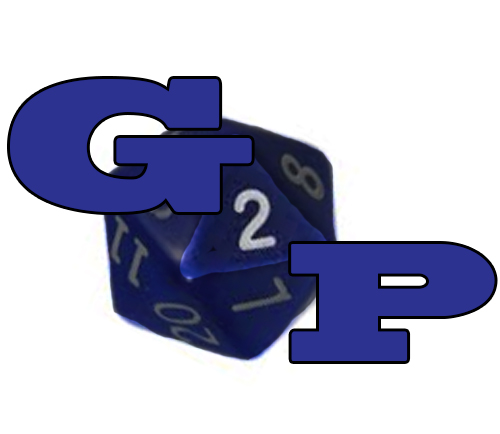
G2P (“Games 2 Play”) is a semi-regular editorial segment from GM Chris, and is devoted to showcasing the rare, the unusual, the crazy, the Indie, and (only very occasionally) the wildly popular in the tabletop RPG world. Games that you either didn’t know existed, games that you should try out as soon as you can, games that will make you laugh or hang your jaw in wonder at their amazeballs glory. In other words: games to play. This episode…
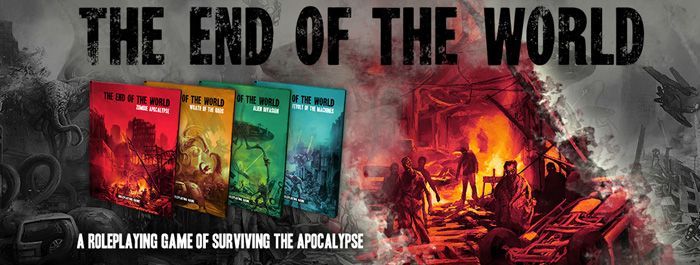
The apocalypse. Gamers…we love it. (Not the actual thing…no. But the concept. The notion.) The idea that the world we know and love will all come crashing down into a fiery hell of alien lasers, Old Ones rising from the depths, singularity events, or hordes of undead ravaging the countryside – these things have been a part of our collective geek consciousness since Lovecraft begin writing, since Romero first terrorized audiences, and since numerous other literary, film, and pop culture references immortalized the idea of surviving the end of all things.
And, understandably, these ideas have influenced more than one tabletop RPG. Dozens of titles have been crafted to let players get their apocalyptic and post-apocalyptic groove on; ranging from the ultra-serious interpersonal tension of a game like Apocalypse World, to the tongue-in-cheek wackiness of Gamma World. Aftermath!, Broken Earth, Skies of Glass, Atomic Highway, Darwin’s World, Exodus, Earthdawn, the ubiquitous Rifts, and – of course – the recent ridiculously successful far-future post apocalypse of Monte Cook’s Numenera. And these are just the games that I own. One might argue there isn’t a single genre more universally thrown towards the masses by game manufacturers of all types than “apocalypse.”
So when I heard early in 2015 that FFG was about to release their own apocalypse RPG – I’ll be frank, I was a bit skeptical. Because, as my personal apocalypse RPG library list should tell you, I asked the question: is there any un-trodden ground left? I was even more dubious when FFG announced that this game, The End of the World, would be released “Star Wars Style” with multiple core rulebooks. Four, to be exact.
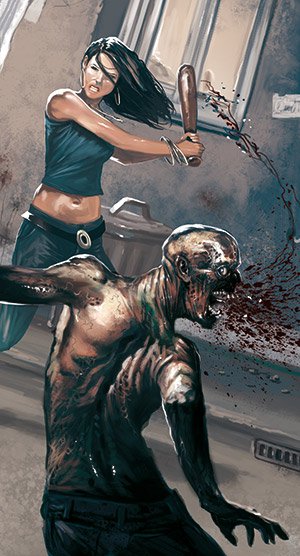
When the game came… I let it pass me by. The first release (the red-covered The End of the World: Zombie Apocalypse) was critically hailed. Fans loved it. Reddit sub-forums exploded (like so many zombie heads splattered by cricket bats). And I? I scoffed. Like a sad, angry child, I scoffed. I’m not going to act like the FFG fanboy that everyone knows I am, I would tell myself. I’ve got a shelf and a thumb drive FILLED with superb apocalypse games! I don’t… need… another… one.
So is that the end of this article? GMC holds his mental fortitude up high and doesn’t get his grubby mitts on a copy of The End of the World? Of course not. This is me. And I have crazy friends. Some of whom actually work for FFG. And when one of those friends tells me that this is actually a really good RPG and I should play it. And then another, and another, and another (all of whom, I respect as gamers) tell me this RPG is fun, fast, and above all – unique – I listen. Because that’s what you do.
I waited until the 2nd book in the line came out digitally (the yellow-jacketed The End of the World: Wrath of the Gods) and then picked up both it and Zombie Apocalypse. After a few hours of voracious reading… I was hooked, and I had to run it immediately. And I did.
The End of the World is not your average apocalypse RPG. It’s primary conceit (which is just utterly brilliant) is that as players, you create characters that are you. The group is literally playing themselves surviving the apocalypse – and the apocalypse starts as the group is – in game – sitting down to play The End of the World RPG. That, alone, sold me. But when you finally start digging into the character creation mechanics and resolution mechanics of the game, you’re left with a beautifully simple experience that is fun, narrative, and can handle just about anything.
Creating characters of “yourselves” is one of the most memorable and fun parts of the game, and players are given a number of build points to spread across 6 characteristics in 3 categories (characteristics are things like “Dexterity,” “Willpowe,r” or “Charisma”). These characteristics are broad summations of your current capabilities, as you see them. But wait – you’re not done…you see, the game keeps you honest.

After assigning points to your characteristics, the rest of the group undergoes a secret voting process for each of your categories (that was surprisingly fast and simple) to decide if you’ve over-stated it, or sold yourself short. The group might decide that you’re a better talker than you think you are, or that you’re not as dexterous as you claim. Depending on the results of the vote, you may be increasing or decreasing a characteristic. The lowest you can go (where all characteristics start) is 1 – where the bottom percentage of the population lives; and the best you can do is a 5 – where the top percentage of people power-lift, chess-master, or silver-tongue their way to glory.
Additionally, you’re going to have positive and negative features that are unique for each category. These represent unusual circumstantial bonuses and penalties you’ll take in certain situations that put you outside the norm. For example, a PC might have an average Dexterity of 2 (seen as mildly clumsy), but is a crack-shot at the shooting range. A PC may have a very high Charisma of 4 or 5, but can’t lie to save their lives. Little detailed features like this not only represent personality and experience quirks each of us have, but they have concrete impacts in the game, and can be called up on to enhance or penalize rolls that characters make.
Characters also record any Traumas they start the game with, since you’re playing yourself. If you have a leg in a cast, or just went through a nasty breakup, you might start the game with these difficult traumas already a hindrance to your character.
Then – equipment. Equipment “buying” has never been so easy. What items do you – YOU – have on your person right now? Yeah, that’s your equipment list. Be sure to note the charge on your cell phone, please.
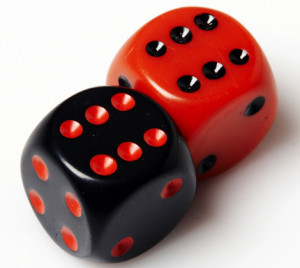
The riot that was character creation leads into a surprisingly smooth and simple narrative dice mechanic, which seems to be FFG’s style, of late. The game uses only d6s – and you’ll want to have several in two different colors; one color will represent positive dice, one color will represent negative dice. All dice rolls consist of building a simple positive and negative dice pool.
Each roll starts with 1 free positive die. After that, you can add additional positive dice for equipment that may help you, positive features you may have that impact the situation at hand, or circumstantial/environmental effects. Negative dice are assigned by the GM based on inherent danger of the task, negative features you may have that hinder the situation, or circumstantial/environmental effects. Then, after the GM informs which of your characteristics governs the roll – you roll all those dice!
After rolling, the first step it to cancel out any positive and negative dice that rolled the same number; those 2 matching dice are simply removed from the results. Then, you examine any remaining positive dice. If at least one of them rolled at or below your characteristic – you succeed! BUT, any uncanceled negative dice cause you to suffer STRAIN (a form of condition management that can lead to Trauma for your character).
The upshot is that the system is surprisingly easy to adjudicate and build rolls for – but has a gritty, “earned injury” feel to Strain and Traumas. Depending on how long the campaign runs, you become more hardened to minor troubles and Strain you face, but will eventually have to trade your strain into lasting Trauma. It’s one of the rare times that he mechanics were CLEARLY designed around the theme of the game, and not the other way around.
The books are gorgeous productions – but only about the first third is devoted to rules/mechanics. The rest is devoted to a highly educational GMing chapter and set of 5 fully fleshed out scenarios to take your players through a full campaign. It was a bit confusing, at first, but it quickly came to me: the core rulebooks for The End of the World share (literally, re-print) the same mechanics and most of the GMing chapter. What differentiates the book lines are the pre-baked scenarios within.
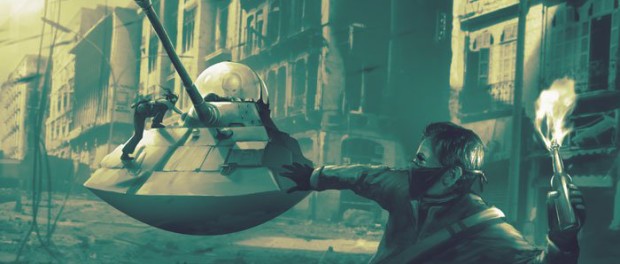
You want to fight Cthulhu and Starspawn from beyond the Cosmos? Or run from Zombies chasing you while you struggle to stay uninfected? Or perhaps fend off Martian invaders bent on breeding with all humanity? Maybe you are the few survivors of an AI Singularity bent on wiping out the “virus” of humanity. Bottom line, each of these “flavors” is one of the books in the The End of the World line. The 5 scenarios laid out in each book follow that particular “apocalyptic theme” – so you can really tailor the scenario to what you and your group would most enjoy.
This really means you don’t have to purchase more than one book, unless (like me) you’re eager to have pre-generated scenarios and campaigns of all stripes and types. But one book will give you the general mechanics, and a skilled GM can really take it from there, even crafting their own unique apocalyptic scenarios!
The only two volumes available for purchase at the moment are The End of the World: Zombie Apocalypse and The End of the World: Wrath of the Gods. The Zombie book was all about ZOMBIES, but each scenario dealt with different types of zombies and government/societal reaction. I’ll admit, I enjoyed Wrath of the Gods more, just because the subject matter was right up my alley. Modules for a “Nature takes back Earth” scenario, a classical Nordic Ragnarok, a return of Aztec deities, stars aligning for the Old Ones, and – of course – the good ‘ole Rapture.
What’s my final verdict? This game is a blast to play. My players had an absolute hoot making themselves into the RPG world, and the mechanics were super-easy, yet meaningful. There have been very few times I’ve felt my players genuinely get nervous or scared at the table. And I managed to do that (with a psychotic HORSE, of all things). An excellent game for a short campaign, or even a few-hours one-shot.
You can find The End of the World: Zombie Apocalypse in paper-print form at stores right now for $40 (hardcover). It’s also available as a PDF, along with The End of the World: Wrath of the Gods (only available as PDF, right now) for $20 each. Check it out: https://www.fantasyflightgames.com/en/products/the-end-of-the-world/
Even as a download, this game is just superb. PLAY IT.
Peace, Love, and Good Gaming – GMC
(All names, references, and pictures presented in this article are Copyright 2015 to Fantasy Flight Games, all rights reserved by their respected owners. This article is a media work of review and publicity, and is in no way intended to share intellectual property or copyrighted material outside the scope of media review.)
